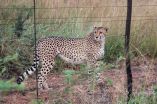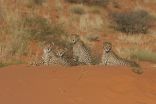(Press-News.org) Scientists at the University of California, Santa Cruz, using a new wildlife tracking collar they developed, were able to continuously monitor the movements of mountain lions in the wild and determine how much energy the big cats use to stalk, pounce, and overpower their prey.
The research team's findings, published October 3 in Science, help explain why most cats use a "stalk and pounce" hunting strategy. The new "SMART" wildlife collar--equipped with GPS, accelerometers, and other high-tech features--tells researchers not just where an animal is but what it is doing and how much its activities "cost" in terms of energy expenditure.
"What's really exciting is that we can now say, here's the cost of being a mountain lion in the wild and what they need in terms of calories to live in this environment," said first author Terrie Williams, a professor of ecology and evolutionary biology at UC Santa Cruz. "Understanding the energetics of wild animals moving in complex environments is valuable information for developing better wildlife management plans."
The researchers were able to quantify, for example, the high energetic costs of traveling over rugged terrain compared to the low cost of "cryptic" hunting behaviors such as sit-and-wait or stalk-and-ambush movements. During the actual pounce and kill, the cats invest a lot of energy in a short time to overpower their prey. Data from the collars showed that mountain lions adjust the amount of energy they put into the initial pounce to account for the size of their prey.
"They know how big a pounce they need to bring down prey that are much bigger than themselves, like a full-grown buck, and they'll use a much smaller pounce for a fawn," Williams said.
Before Williams and her team could interpret the data from collars deployed on wild mountain lions, however, they first had to perform calibration studies with mountain lions in captivity. This meant, among other things, training mountain lions to walk and run on a treadmill and measuring their oxygen consumption at different activity levels. Those studies took a bit longer than planned.
"People just didn't believe you could get a mountain lion on a treadmill, and it took me three years to find a facility that was willing to try," Williams said.
Finally, she met Lisa Wolfe, a veterinarian with Colorado Parks and Wildlife, who had three captive mountain lions (siblings whose mother had been killed by a hunter) at a research facility near Fort Collins, Colorado. After eight months of training by Wolfe, the mountain lions were comfortable on the treadmill and Williams started collecting data.
According to Williams, the treadmill data showed that mountain lions do not have the aerobic capacity for sustained, high-energy activity. "They are power animals. They have a slow routine walking speed and use a burst of speed and the force of the pounce to knock down or overpower their prey," she said.
In addition to the treadmill studies, the captive cats were videotaped wearing the collars while doing a wide range of activities in a large outdoor enclosure. This provided a library of collar acceleration signatures specific for different behaviors, from resting and grooming to running and pouncing. "We got all the different behaviors videotaped and analyzed with the corresponding accelerometer traces," Williams said.
Meanwhile, coauthor Chris Wilmers led a team that deployed the collars on wild cats in the Santa Cruz mountains. Wilmers, an associate professor of environmental studies at UC Santa Cruz, leads the Santa Cruz Puma Project, which has been tracking mountain lions in the area to study the effects of habitat fragmentation and developing new technology for understanding the animals' behavior and energetics.
"Because mountain lions are a cryptic animal, we can't really observe them hunting and killing prey. With the SMART collars, we can see how they go about doing that, what their strategies are, and how many calories they are expending to do it," Wilmers said. "The ability to estimate the field energetics of animals in the wild opens up a whole new suite of questions we can ask about the ecology of these animals, which ultimately informs not only our basic understanding of them but also their conservation and management."
Coauthor Gabriel Elkaim, professor of computer engineering at UCSC's Baskin School of Engineering, worked on signal processing of the accelerometer data and is continuing to develop the state-of-the-art tracking collars. The prototype used in this study, called the Species Movement, Acceleration, and Radio Tracking (SMART) wildlife collar, was developed by computer engineering graduate student Matthew Rutishauser. The collars include a GPS unit, accelerometers, and a magnetometer to provide detailed data on where an animal is and what it is doing. "We hope this will be an enabling technology to allow a much greater depth of understanding of animals in the wild," Elkaim said.
The researchers now want to look at mountain lion energetics in a range of different habitat types. In particular, Wilmers said, he is interested in how human land use and habitat fragmentation may be influencing the energetic demands on mountain lions in the wild. Williams and her students also have projects using the new collar technology to study other large carnivores, including wolves, polar bears, and Weddell seals.
"A lot of these large carnivore species are threatened or endangered, and understanding their physiological limitations has been a big missing piece in conservation planning," Williams said. "This technology gives us a whole new level understanding of what these animals are doing and what it costs them to live in the wild, and that can really help move the science of conservation forward."
INFORMATION:
In addition to Williams, Wilmers, Wolfe, and Elkaim, the coauthors of the paper include Tracy Davis at Colorado Parks and Wildlife; program manager Traci Kendall and head trainer Beau Richter in Williams's lab at UC Santa Cruz; and UCSC graduate students Yiwei Wang and Caleb Bryce. This research was funded by the National Science Foundation.
Study of mountain lion energetics shows the power of the pounce
High-tech collars enable scientists to record the energetics of mountain lion hunting behavior, showing why cats use 'stalk and pounce' and how they overpower large prey
2014-10-02
ELSE PRESS RELEASES FROM THIS DATE:
Thermotolerant yeast can provide more climate-smart ethanol
2014-10-02
VIDEO:
This is a video interview with Jens Nielsen.
With a simple mutation, yeast can grow in higher than normal temperatures. Researchers at Chalmers University of Technology demonstrate this in an article...
Click here for more information.
With a simple mutation, yeast can grow in higher than normal temperatures. Researchers at Chalmers University of Technology demonstrate this in an article to be published in the scientific journal Science. The findings may result in ethanol ...
Cheetahs never prosper: Energy expenditure linked to population decline
2014-10-02
Wild cheetah populations have declined precipitously in the past century: from an estimated 100,000 in 1900 to only around 10,000 today. A new study from researchers in Europe, South Africa and at North Carolina State University suggests that the energy cheetahs spend looking for prey, rather than their high-speed hunting tactics or food stolen by other predators, may be to blame for their dwindling numbers.
Cheetahs are high-speed hunters, but are not the strongest predators in their ecosystems. Often, hyenas and lions will take advantage of this, stealing the cheetah's ...
Princeton scientists observe elusive particle that is its own antiparticle
2014-10-02
VIDEO:
Princeton University researchers first deposited iron atoms onto a lead surface to create an atomically thin wire. They then used a scanning-tunneling microscope to create a magnetic field and to...
Click here for more information.
Princeton University scientists have observed an exotic particle that behaves simultaneously like matter and antimatter, a feat of math and engineering that could yield powerful computers based on quantum mechanics.
Using a two-story-tall microscope ...
HIV pandemic's origins located
2014-10-02
The HIV pandemic with us today is almost certain to have begun its global spread from Kinshasa, the capital of the Democratic Republic of the Congo (DRC), according to a new study.
An international team, led by Oxford University and University of Leuven scientists, has reconstructed the genetic history of the HIV-1 group M pandemic, the event that saw HIV spread across the African continent and around the world, and concluded that it originated in Kinshasa. The team's analysis suggests that the common ancestor of group M is highly likely to have emerged in Kinshasa around ...
New map exposes previously unseen details of seafloor
2014-10-02
Accessing two previously untapped streams of satellite data, scientists at Scripps Institution of Oceanography at UC San Diego and their colleagues have created a new map of the world's seafloor, creating a much more vivid picture of the structures that make up the deepest, least-explored parts of the ocean. Thousands of previously uncharted mountains rising from the seafloor and new clues about the formation of the continents have emerged through the new map, which is twice as accurate as the previous version produced nearly 20 years ago.
Developed using a scientific ...
New study suggests humans to blame for plummeting numbers of cheetahs
2014-10-02
A new study led by Queen's University Belfast into how cheetahs burn energy suggests that human activity, rather than larger predators, may force them to expend more energy and thus be the major cause of their decline.
Wild cheetahs are down to under 10,000 from 100,000 a century ago with conventional wisdom blaming bigger predators for monopolising available food as their habitat becomes restricted. The traditional thinking has been that cheetahs no longer have sufficient access to prey to fuel their enormous energy output when engaging in super-fast chases.
But, ...
New approach to boosting biofuel production
2014-10-02
CAMBRIDGE, MA -- Yeast are commonly used to transform corn and other plant materials into biofuels such as ethanol. However, large concentrations of ethanol can be toxic to yeast, which has limited the production capacity of many yeast strains used in industry.
"Toxicity is probably the single most important problem in cost-effective biofuels production," says Gregory Stephanopoulos, the Willard Henry Dow Professor of Chemical Engineering at MIT.
Now Stephanopoulos and colleagues at MIT and the Whitehead Institute for Biomedical Research have identified a new way to ...
Falling asleep: Revealing the point of transition
2014-10-02
How can we tell when someone has fallen asleep? To answer this question, scientists at Massachusetts General Hospital have developed a new statistical method and behavioural task to track the dynamic process of falling asleep.
Dr Michael Prerau, Dr Patrick Purdon, and their colleagues used the evolution of brain activity, behaviour, and other physiological signals during the sleep onset process to automatically track the continuous changes in wakefulness experienced as a subject falls asleep.
The study, publishing today in PLOS Computational Biology, suggests that it ...
Researchers identify new pathway linking the brain to high blood pressure
2014-10-02
VIDEO:
Dr. Frans Leenen, from the University of Ottawa Heart Institute, discusses the importance of these new findings.
Click here for more information.
Ottawa, ON and Baltimore, MD, October 2, 2014—New research by scientists at the Ottawa Heart Institute and the University of Maryland School of Medicine (UM SOM) has uncovered a new pathway by which the brain uses an unusual steroid to control blood pressure. The study, which also suggests new approaches for treating high blood ...
York academics reveal new findings about insect diversification
2014-10-02
Biologists from the University of York have compiled two new datasets on insect evolution, revealing that metamorphosing insects diversify more quickly than other insects and are therefore the biggest contributors to the evolution of insect diversity.
Both funded by the Natural Environment Research Council (NERC), the first dataset is a complete fossil catalogue showing timescales of origination and extinction of different families of insects. Working with the Natural History Museum and National Museums Scotland, former PhD student Dr David Nicholson collated a database ...
LAST 30 PRESS RELEASES:
Tracing the quick synthesis of an industrially important catalyst
New software sheds light on cancer’s hidden genetic networks
UT Health San Antonio awarded $3 million in CPRIT grants to bolster cancer research and prevention efforts in South Texas
Third symposium spotlights global challenge of new contaminants in China’s fight against pollution
From straw to soil harmony: International team reveals how biochar supercharges carbon-smart farming
Myeloma: How AI is redrawing the map of cancer care
Manhattan E. Charurat, Ph.D., MHS invested as the Homer and Martha Gudelsky Distinguished Professor in Medicine at the University of Maryland School of Medicine
Insilico Medicine’s Pharma.AI Q4 Winter Launch Recap: Revolutionizing drug discovery with cutting-edge AI innovations, accelerating the path to pharmaceutical superintelligence
Nanoplastics have diet-dependent impacts on digestive system health
Brain neuron death occurs throughout life and increases with age, a natural human protein drug may halt neuron death in Alzheimer’s disease
SPIE and CLP announce the recipients of the 2025 Advanced Photonics Young Innovator Award
Lessons from the Caldor Fire’s Christmas Valley ‘Miracle’
Ant societies rose by trading individual protection for collective power
Research reveals how ancient viral DNA shapes early embryonic development
A molecular gatekeeper that controls protein synthesis
New ‘cloaking device’ concept to shield sensitive tech from magnetic fields
Researchers show impact of mountain building and climate change on alpine biodiversity
Study models the transition from Neanderthals to modern humans in Europe
University of Phoenix College of Doctoral Studies releases white paper on AI-driven skilling to reduce burnout and restore worker autonomy
AIs fail at the game of visual “telephone”
The levers for a sustainable food system
Potential changes in US homelessness by ending federal support for housing first programs
Vulnerability of large language models to prompt injection when providing medical advice
Researchers develop new system for high-energy-density, long-life, multi-electron transfer bromine-based flow batteries
Ending federal support for housing first programs could increase U.S. homelessness by 5% in one year, new JAMA study finds
New research uncovers molecular ‘safety switch’ shielding cancers from immune attack
Bacteria resisting viral infection can still sink carbon to ocean floor
Younger biological age may increase depression risk in older women during COVID-19
Bharat Innovates 2026 National Basecamp Showcases India’s Most Promising Deep-Tech Ventures
Here’s what determines whether your income level rises or falls
[Press-News.org] Study of mountain lion energetics shows the power of the pounceHigh-tech collars enable scientists to record the energetics of mountain lion hunting behavior, showing why cats use 'stalk and pounce' and how they overpower large prey




